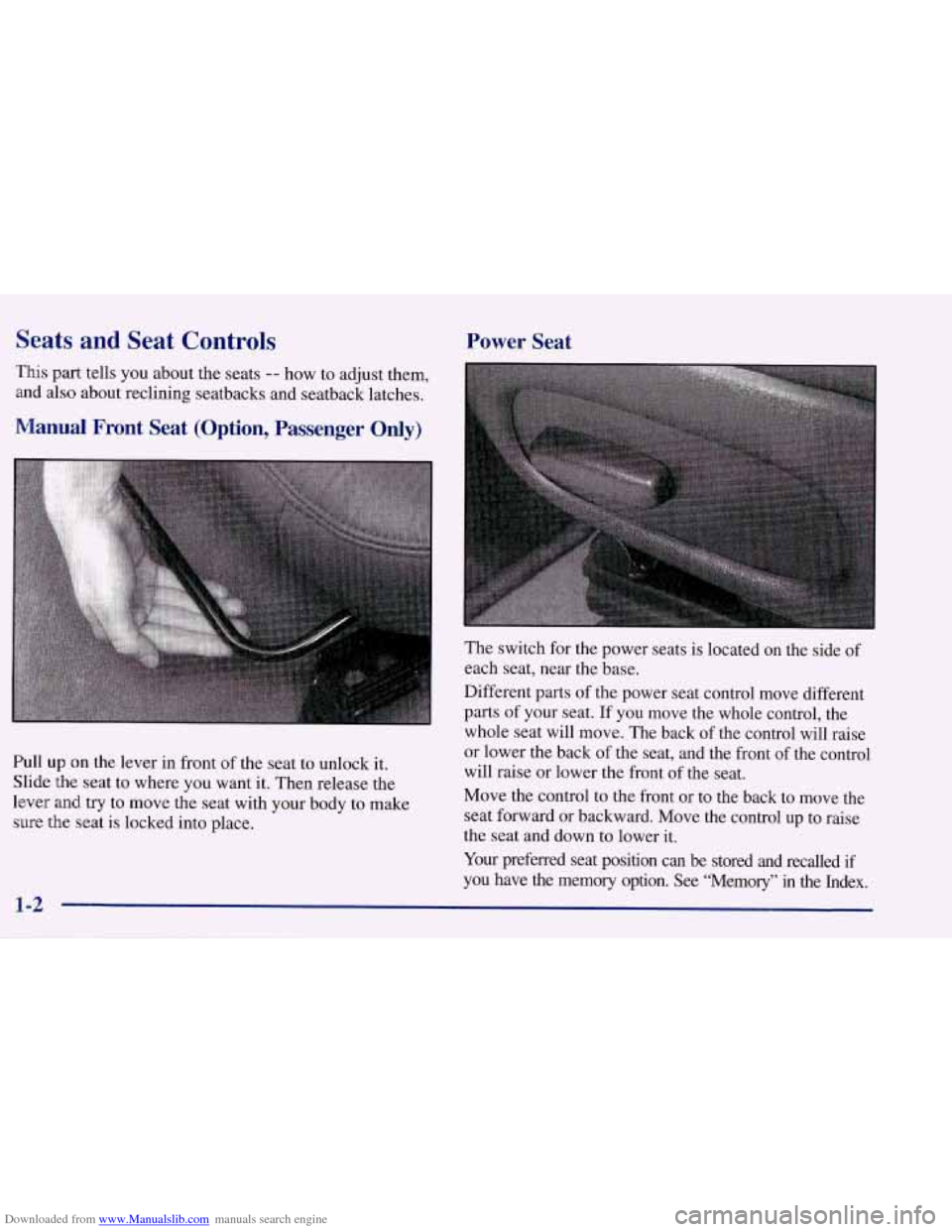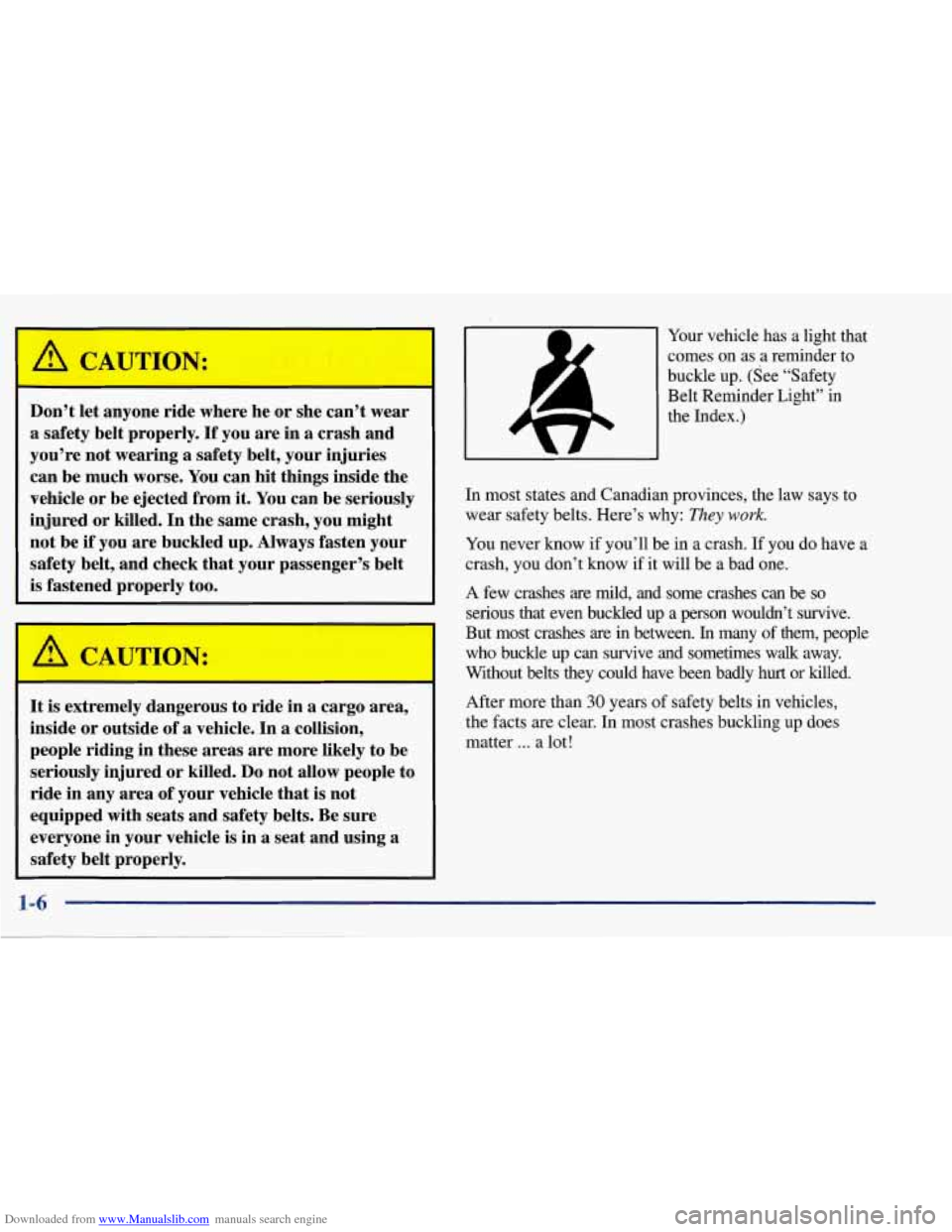Page 17 of 378

Downloaded from www.Manualslib.com manuals search engine Seats and Seat Controls Power Seat
This part tells you about the seats -- how to adjust them,
and also about reclining seatbacks and seatback latches.
Manual Front Seat (Option, Passenger Only)
Pull up on the lever in front of the seat to unlock it.
Slide the seat to where you want it. Then release the
lever and
try to move the seat with your body to make
sure the seat
is locked into place.
1-2
The switch for the power seats is located on the side of
each seat, near the base.
Different parts of the power seat control move different
parts
of your seat. If you move the whole control, the
whole seat will move. The back
of the control will raise
or lower the back
of the seat, and the front of the control
will raise or lower the front of the seat.
Move the control to the front or to the back to move the
seat forward or backward. Move the control up to raise
the seat and down to lower it.
Your preferred seat position can be stored and recalled if
you have the memory option.
See “Memory” in the Index.
Page 18 of 378
Downloaded from www.Manualslib.com manuals search engine Sport Seat (Option) Reclining Seatbacks
In addition to the power seat control, there are three
other switches that help
you change the shape of your
seat. There are two lumbar supports
(A and B) for the
middle and lower back. There’s also a side bolster
switch
(C) that adjusts the sides of the seat around you
to give you more lateral support.
For lumbar support, move each switch
(A and B)
forward to inflate or rearward to deflate.
Move the side bolster switch
(C) up for more side
support and down for less support. The lever
for the reclining seatback
is located on the
side
of each seat, near the base.
To adjust the seatback, pull up on the lever and tilt the
seatback to where
you want it. Release the lever to lock
the seatback into place.
1-3
Page 19 of 378
Downloaded from www.Manualslib.com manuals search engine But don’t have a seatback reclined if your vehicle
is
moving.
I Sitting in a reclined position when your vehicle is
in motion can be dangerous. Even if you buckle
up, your safety belts can’t do their job when
you’re reclined like this.
The shoulder belt can’t do its job because it
won’t be against your body. Instead, it will be in
front of you. In
a crash you could go into it,
receiving neck or other injuries.
The lap belt can’t do its job either. In a crash the
belt could
go up over your abdomen. The belt
forces would be there, not at your pelvic bones.
This could cause serious internal injuries.
For proper protection when the vehicle is
in
motion, have the seatback upright. Then sit well
back
in the seat and wear your safety belt properly.
Page 20 of 378
Downloaded from www.Manualslib.com manuals search engine Seatback Latches
I A CAUTION:
Both seatbacks fold forward to give you access to the
rear area.
To fold a seatback forward, lift this latch and
pull the seatback forward. The seatback will lock down
in this position.
To unlock, lift up on the latch and push
the seatback rearward. When you return the seatback to
its original position, make sure the seatback is locked.
If the seatback isn’t locked, it could move
forward in a sudden stop or crash. That
could cause injury to the person sitting there.
Always press rearward on the seatback to be sure it is locked.
Safety Belts: They’re for Everyone
This part of the manual tells you how to use safety belts
properly. It also tells you some things
you should not do
with safety belts.
And it explains the air bag system.
1-5
Page 21 of 378

Downloaded from www.Manualslib.com manuals search engine Don’t let anyone ride where he or she can’t wear
a safety belt properly.
If you are in a crash and
you’re not wearing
a safety belt, your injuries
can be much worse. You can hit things inside the
vehicle or be ejected from it. You can be seriously
injured or killed. In the same crash, you might
not be if you are buckled up. Always fasten your
safety belt, and check that your passenger’s belt
is fastened properly too.
Your vehicle has a light that
comes on as a reminder to
buckle up. (See “Safety
Belt Reminder Light” in
the Index.)
In most states and Canadian provinces, the law says to
wear safety belts. Here’s why:
They work.
You never know if you’ll be in a crash. If you do have a
crash, you don’t know if it will be a bad one.
A few crashes are mild, and some crashes can be so
serious that even buckled up a person wouldn’t survive.
But most crashes are in between.
In many of them, people
who buckle up can survive and sometimes walk away.
Without belts
they could have been badly hurt or killed.
After more than 30 years of safety belts in vehicles,
the facts are clear. In most crashes buckling up does
matter
... a lot!
It is extremely dangerous to ride in a cargo area,
inside or outside of a vehicle. In
a collision,
people riding in these areas are more likely to be
seriously injured or killed.
Do not allow people to
ride in any area of your vehicle that is not
equipped with seats and safety belts. Be sure
everyone in your vehicle
is in a seat and using a
safety belt properly.
1-6
Page 22 of 378
Downloaded from www.Manualslib.com manuals search engine Why Safety Belts Work
When you ride in or on anything, you go as fast as
it goes.
Take the simplest vehicle. Suppose it's just
a seat
on wheels.
Put someone on it.
1-7
Page 23 of 378
Downloaded from www.Manualslib.com manuals search engine c
Get it up to speed. Then stop the vehicle. The rider
doesn’t stop. The person keeps going
until stopped by something.
In
a real vehicle, it could be the windshield ...
Page 24 of 378
Downloaded from www.Manualslib.com manuals search engine or the instrument panel ... or the safety belts!
With safety belts, you slow down as the vehicle does.
You get more time to stop. You stop over more distance,
and your strongest bones take the forces. That’s
why
safety belts make such good sense.
1-9